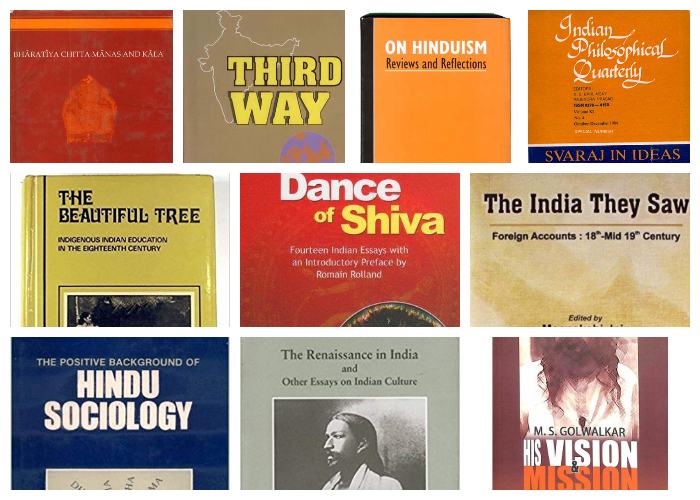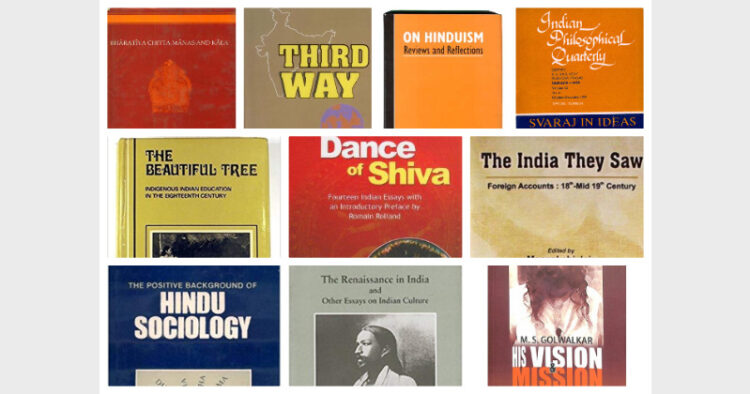
In the wake of preventive measures of the Government of India to curb the spread of Covid-19, and to encourage people to #StayHome, the Human Resource Development Ministry has introduced a new initiative called #StayHomeIndiaWithBooks. In its efforts to encourage people to read books while at home, the National Book Trust under the HRD ministry has provided select and best-selling titles for free download as part of its initiative of #StayHomeIndiaWithBooks.
In this backdrop, Organiser publishes a series titled ‘ #TheGreatIndianReadBookList ‘, a reading list recommended by India’s leading public intellectuals. The series aims to introduce to our readers a few books that every Indian must read in her/his lifetime.
Here’s a list of 10 must-read books recommended by Dr Anirban Ganguly:
(Dr. Anirban Ganguly is the Director of Dr. Syama Prasad Mookerjee Research Foundation (SPMRF), a New Delhi based think tank affiliated to the Bharatiya Janata Party (BJP). He is a Member of the Policy Research Department of BJP and the National Co-Convener of the BJP’s Library and Documentation Department. Dr Ganguly is a scholar of civilisation, history, politics and culture. He holds a PhD in education from Jadavpur University, Kolkata and had his early education at Sri Aurobindo International Centre of Education, Sri Aurobindo Ashram, Puducherry. He has authored/edited/co-edited the following books, ‘Syama Prasad Mookerjee: His Vision of Education (2017) “The Modi Doctrine: New Paradigms in India’s Foreign Policy” (2016), “Redefining Governance: Essays on One year of Narendra Modi Government” (2015), “Swami Vivekananda, Buddha & Buddhism” (2014) “Debating Culture” (2013), “Education: Philosophy & Practice” (2011). He has also authored numerous papers, chapters and monographs on civilisational issues, politics, education and culture and is a columnist with a number of leading dailies. Source: http://www.anirbanganguly.in/about )
1. “The Positive Background of Hindu Sociology” by Benoy Kumar Sarkar
“The Positive Background of Hindu Sociology” is mainly an analytical study of Sukracharya’s code so that the data of Hindu Sociology collected here reflect generally those phases of Indian cultural evolution, which have influenced the authors of the Sukra cycle. The book represents chiefly such landmarks in the culture history of the Hindus as are embodied in the single document Sukraniti.
(Read more about the book: https://books.google.co.in/books/about/The_Positive_Background_of_Hindu_Sociolo.html)
Download here: (https://archive.org/details/in.ernet.dli.2015.264261/page/n1)
2. “The Dance of Shiva” by Ananda Coomaraswamy
Ananda Coomaraswamy, late curator of Indian art at the Boston Museum of Fine Arts, was unexcelled in his knowledge of the arts of the Orient, and unmatched in his understanding of Indian culture, language, religion, and philosophy. In this excellent reprint of a rare volume of essays, he reveals the essence of the Indian experience, rooted in “a constant intuition” of the unity and harmony of all life. Everything has its place, every being its function and all play a part in the divine concert led by Natar?j? (?iva), Lord of Dancers. In a series of 14 stimulating and provocative essays, Coomaraswamy unfolds the vast metaphysic of India: the magnificent revelation of its art; its conception of the universe; social organization; attitudes toward feminism; problems of family; romantic love, and marriage. His sweeping commentary considers the “intellectual fraternity” of mankind; the venerable past as it survives side by side with emerging modern India; and the individual, autonomy, and repudiation of “the will to govern.”
(Read more about the book: https://www.goodreads.com/book/show/915845.The_Dance_of_Siva)
Download here: (https://archive.org/stream/danceofsivafourt01coomuoft/danceofsivafourt01coomuoft_djvu.txt)
3. “The Renaissance in India And Other Essays On Indian Culture” by Sri Aurobindo
A defence of Indian civilisation and culture, with essays on Indian spirituality, religion, art, literature, and polity. Sri Aurobindo began the ‘Foundations’ series as an appreciative review of Sir John Woodroffe’s book, ‘Is India Civilised?’, continued it with a rebuttal of the hostile criticisms of William Archer in ‘India and Its Future’, and concluded it with his own estimation of India’s civilisation and culture.
In Sri Aurobindo’s view, India is one of the greatest of the world’s civilisations because of its high spiritual aim and the effective manner in which it has impressed this aim on the forms and rhythms of its life. “A spiritual aspiration was the governing force of this culture”, he wrote, “its core of thought, its ruling passion. Not only did it make spirituality the highest aim of life, but it even tried…to turn the whole of life towards spirituality.” Sri Aurobindo held that an aggressive defence of India culture was necessary to counter the invasion of the predominantly materialistic modern Western culture. His Foundations is precisely such a defence. (Read more about the book: https://www.goodreads.com/book/show/12169499-the-renaissance-in-india-and-other-essays-on-indian-culture)
4. “Swaraj in Ideas” by KC Bhattacharya
In the year 1929, K.C. Bhattacharya – one of the most incisive philosophical minds that modern India could produce, delivered a lecture called ‘Swaraj in India’, which is one of the most important texts emerging from our long – drawn – out struggle for independence. Bhattacharya had, in that essay, spoken of two dangers: ‘the greatest danger’, in his view, was our blind subservience to ‘the so-called universalism of reason or religion’ which, being the result of a rootless education, stood more than anything else in the way of ‘Swaraj in ideas’. As for the other danger of national conceit and obscurantism, ‘it needed less stressing’, in his opinion, because, to quote his words, “our educated men suffer from over-diffidence than from over-confidence. We are readier to accept others’ judgments about us than to resent them.” (
Download here: http://library.bjp.org/jspui/handle/123456789/166
5. “MS Golwalkar: His Vision and Mission” compiled by Shri R Hari
RSS Sarsanghchalak Dr Mohan Bhagwat, as the then Sarkayavah of RSS wrote in the foreword of the book, ‘MS Golwalkar: His Vision and Mission’: “Twelve volumes containing Sri Guruji speeches writings conversation and letters they have already been brought out. Naturally, they cover many subjects, some of them of contemporary relevance and some others of all time relevance. Time never stands still and circumstances do change. But thoughts of eternal values have relevance all through, they are ever sought for as and when occasions arise and in turn, they give right guidance providing right solutions. With this belief, a small team of capable hands joined together to gather such abiding thoughts of Sri Guruji from the aforesaid volumes and this anthology is the results.”
Later in 2018, while answering a question on Guruji’s ‘Bunch of Thoughts’ in a three-day lecture series ‘Bhavishya ka Bharat’, Sarsanghchalak Dr Mohan Bhagwat recommended this book to the readers to know about the vision and philosophy of the Sangh in the words of of Guruji Golwalkar. “So far as Bunch of Thoughts is concerned, every statement carries a context of time and circumstance…his enduring thoughts are in a popular edition (MS Golwalkar: His Vision and Mission) in which we have removed all remarks that have a temporary context and retained those that will endure for ages,” he said.
Buy here: https://www.kurukshethrabooks.com/books/product/his-vision-mission–m-s-golwalkar
6. “Third Way” by Dattopant Thengadi
Shri Dattopant Bapurao Thengadi was a great thinker, nationalist intellectual, Hindutva ideologue, trade union leader and founder of the Swadeshi Jagaran Manch, Bharatiya Mazdoor Sangh and the Bharatiya Kisan Sangh.
In the background of the withering of communism and the imminent collapse of capitalism, time is ripe for exploring a more universally acceptable ‘Third Way’. Several leading thinkers like Peter Drucker and Paul Samuelson have – though guardedly – predicted that capitalism in its present form may not survive beyond the first quarter of the next century. However, the collapse of these systems cannot automatically usher in a superior world-order. Evolving a ‘Third Way’ desiderates a vast amount of preparatory work at both the intellectual and organisational levels. To pave the way for such exploration is the purpose of the essays and lectures compiles in this volume. (
Buy here: https://www.bookbharati.com/index.php?route=product/product&product_id=535&search=third+way
7. “On Hinduism Reviews and Reflections” by Ramswaroop
In the book, Ram Swarup (1920-1998) outlines a Hindu approach to the problems of the world that offers deep and lasting solutions which go beyond the limitations of Western religions or Western science, following the development of consciousness as the real thrust in civilization.
Ram Swarup has thoroughly and critically studied religions of the world. He can speak of these systems with in-depth knowledge and ability to quote and mirror what they really think. And he has left an important legacy of many works on a broad range of topics including religion and philosophy, yoga, mysticism, and social issues. His Hindu View of Christianity and Islam is a classic in the field of comparative religion, for the first time perhaps introducing a yogic view of altered states of consciousness to understand the powerful and sometimes dangerous working of religious experience.
(Read more about the book: https://www.goodreads.com/book/show/3639742-on-hinduism )
Buy here: (https://www.amazon.in/Hinduism-Reviews-reflections-Ram-Swarup/dp/818599062X)
8. “The Beautiful Tree: Indigenous Indian Education in the Eighteenth Century” by Dharampal
Dharampal was a great Gandhian thinker, historian and political philosopher from India. Convinced about the urgent need for an objective understanding about India’s past, before the onslaught of colonial rule, he decided to embark on an exploration of British-Indian archival material, based on documents emanating from commissioned surveys of the East India Company, lodged in various depositories spread over the British Isles. His pioneering historical research, conducted intensively over a decade, led to the publication of works that have since become classics in the field of Indian studies.
This major work entitled “The Beautiful Tree” provides evidence from extensive early British administrators’ reports of the widespread prevalence of educational institutions in the Bengal and Madras Presidencies as well as in Punjab, teaching a sophisticated curriculum, with daily school attendance by about 30% of children aged 6–15, where those belonging to communities who were classed as Shudras or even lower constituted a good number of students, and in some areas, for instance in Kerala, where Muslim girls were quite well represented. (Read more about the book: https://www.goodreads.com/book/show/17931651-the-beautiful-tree)
Download here: (http://www.arvindguptatoys.com/arvindgupta/beautifultree.pdf)
9. “Bharatiya Chitta Manas aur Kala” by Dharampal
Bharatiya Chitta, Manas and Kala (1991/1993) This philosophical-historical piece, containing deep insights into the Indian civilisational ethos, was first written in Hindi (emanating from discussions with friends in Chennai) in early 1991. The preliminary picture of the Indian mind presented in this essay is, of course, not meant to be final or exhaustive. The attempt is to emphasise the urgent need to understand the Indian Chitta and Kala if India is to once again find her moorings in the present-day world, and to sketch some of the basic aspects of the Indian Chitta and Kala that seem to set the Indians apart from the rest.
(Read more about the book: https://www.goodreads.com/book/show/46035783-bharatiya-chitta-manas-and-kala)
Download here: (http://library.bjp.org/jspui/handle/123456789/967)
10. “The India They Saw” (4 Vols) by Meenakshi Jain and Sandhya Jain
An account of the grandeur of ancient India as perceived by her foreign visitors from hoary times, and their wonder at her rich philosophical efflorescence and material abundance. Beginning with the Greeks and especially those who accompanied Alexander, these accounts comprise our first records into the social, moral, legal, and economic life of the Indian people, and the early development of the civilisational paradigm of dharma, artha, kama and moksa.
This uninhibited intellectual and spiritual exploration of India’s Sanskritic or Indic culture ended abruptly with the rise of Islam in Arabia in the seventh century, and its outward thrust into Europe, North Africa, Central Asia and the Indian sub-continent, where it fought to establish political and religious supremacy. Possibly the last Buddhist monk to take the land route to India was the Korean pilgrim Hye Ch’O, who arrived as the armies of Islam began cutting through Central Asia. (Read more about the book: https://www.goodreads.com/book/show/31706330-the-india-they-saw)
Buy here: (https://www.amazon.in/India-They-Saw-Vol-1/dp/8184301065)













Comments